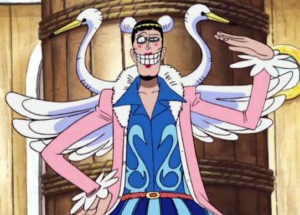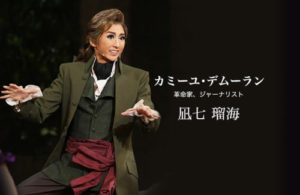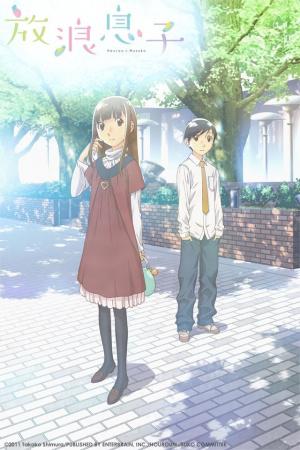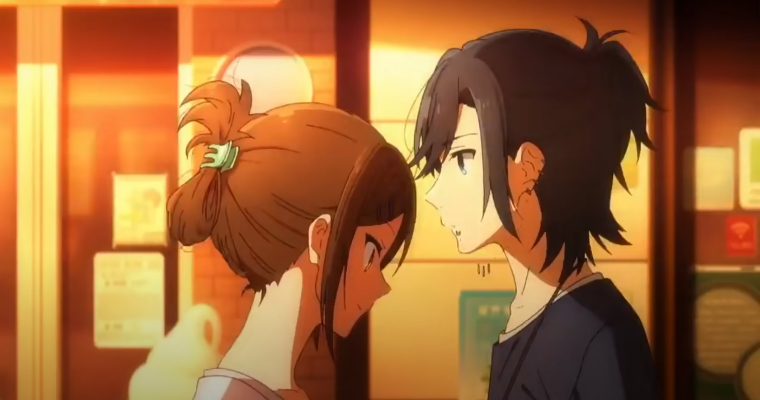Japanese Lesbian/Transgender Identities in Contemporary Media.
The anime and manga community will probably be familiar with the term okama (literally, kettle), variously translated as ‘transvestite’ or ‘Drag Queen’, which is commonly applied to (effeminately) gay characters, especially in a cross-dressing context. 
The (Internationally?) Ghosted Lesbian
Japan’s relatively lenient approach to male-to-male homosexuality, in specific contexts at least, has been discussed previously.[iii] By contrast, hardly anything has been said, or indeed can be said, about the history of women’s non-normative sexualities, in Japan or elsewhere.[iv] In the West, this has been due to the (Victorian) assumption that women are not supposed to even have a sexuality in the first place, and the complete disregard of any possibility of female-to-female sexuality. This has produced what Terry Castle so pointedly termed the ‘Apparitional Lesbian’: non-heterosexual female experience is ghostly, not-quite-real, because lesbian desire fundamentally challenges the patriarchal hegemony.[v] It would of cause be condescending and essentialist to assume that the same principles structured a society as vastly different as that of Japan, but there is a basic similarity – the patriarchal society (Buddhist and Confucianist rather than Victorian Christian, in the case of Japan), which needs to deny deviant sexualities and gender identities to maintain itself. This allows for the assumption, I believe, that female sexuality outside strict lines of necessity (dynastic procreation) was obstructed and condemned in a similar fashion in Japan, and that (especially non-heterosexual) female desire was similarly ghosted. Indeed, there are but a few hints, as Mark McLelland describes in his interesting, though necessarily sketchy, history of female cross-dressing in Japan.[vi]
Therefore, my sources mostly consider only the time period from the 1960s to the present. I am going to take an even narrower focus and try to find some narrative depictions I can mention, and perhaps venture to say a thing or two about their recipients, because that is what I, as a literary scholar, am interested in and feel competent to deal with. So, which images of lesbians and transpeople can one come across in Japanese media?
Imitation and parody: Cross-dressers
A first sign of lesbian visibility, Lez Bars (again a reaction to male Gay Bars) began to open in Tokyo the 1960s. Mainstream magazines covered this trend and their clientele;[vii] allegedly, this consisted of both curious heterosexuals, and two types of lesbian women. In an imitation of heterosexual gender roles (as McLelland points out), there was supposed to be a male role player, called tachi (this term can be linked to the leading actors in (all 
In the more well-known and more popular world of the gay bars, MtF transvestite entertainers were known as gei boi or ‘sister boys’, leading to the term ‘brother girls’ for their lesbian counterparts, though those never achieved comparable popularity. And the entertainment factor complicates the picture. 
If we look to narrative art, girls cross-dressing as boys have appeared a lot in the romantic genre, from Shakespeare to Rose of Versailles. Speaking of shōjo (‘for girls’) manga, depending on where you pinpoint the beginning of the genre, its very first heroine, Tezuka’s Ribon Knight, was a cross-dresser.[xvi] Sadly, cross-dressing (in romantic comedies and elsewhere) tends to be ultimately contained in a heteronormative ending. Even in the funnily deconstructive Ouran High School Host Club. Also, whereas the entertainer/bartender MtF transperson has appeared in popular media – 

Fantastic Lilies and Hammered-In Nails – Fiction and Reality
Previously, I mentioned shōjo manga and romance. Fans of the genre might be familiar with the term yuri (literally, lily) for female homosexuality. This metaphor actually gained currency in the same context; to be precise, in the personal ads columns of Boys’ Love Magazines directed at girl readers. James Welker argues that BL manga help girls to form concepts of sexuality, and since the protagonists are often quite androgynous, the stories can also be read as lesbian. Moreover, while the stories are about boys, the featured articles in the magazines he analyses deal with lesbian themes, and the personal ads are also lesbian.[xvii] The personal ad column of gay magazines being labelled bara tsûshin, ‘rose communication’, so the lesbian equivalent
Therefore, the sheer amount of homosexual and trans characters in romance and comedy fiction should not be misread as a sign of broad social acceptance for deviant sexuality in Japan. Social pressure to stay closeted is strong, so that most queers cannot come out even to friends and family for fear of being rejected and isolated.[xix] Heterosexual marriage and childbirth are seen as conditions for full adulthood, for both genders; thus, while homosexuality is not illegal, homosexual individuals and couples cannot expect legal protection either. The lack of court cases about discrimination is probably based on this fear to stand out in a society which, as the proverb says, ‘hammers in every nail which sticks out’.[xx] Similarly, Japan’s educational system is hampered by heterosexist bias, as Sugiura describes students complaining about the lack of information regarding homosexuality and gender issues.[xxi] As with other personal and social problems, keeping face seems to be most important – whatever you do in your private time, or feel in your heart, do not let it disturb public complacency. Be it families, schools, or companies, it is commonly pretended – to the extent that it is believed – that non-heterosexuals do not exist. Thus, insulting jokes are made without hesitation, and the majority of Japanese believe homosexuality to be ‘wrong’.[xxii]
A man inside? The re-enforcement of the gender binary
Queer individuals themselves suffer from this internalized prejudice. An autobiographic essay on FtM transgender experience, for example, reads: “I learned the term “gender identity disorder” (sei dôistsusei shôgai) [from TV shows], but I couldn’t face such reports head on, as I felt that I couldn’t be one of those freaks (hentai).’[xxiii]
An example of this internalized homophobia is the treatment of the 
This transgression is contained, however, by the fact that Ruka is not portrayed as a tachi lesbian or onabe. Instead, she seeks consultation for gender identity disorder and wishes for sex reassignment surgery – in other words, she is ultimately designated a transsexual in the small-minded way Japanese law acknowledges transpeople [xxiv] – as a heterosexual man in a woman’s body, so to speak. This gives an aura of righteousness to her formerly transgressive actions: she may act and dress in a masculine fashion and desire Michiru, because she is ‘actually’, psychologically, a man, and men are entitled to do so.
Such a view is not only blatantly misogynistic and homophobic. It also depicts transgender feelings and actions as sick and portrays trans people as ‘victims of nature’, who must be treated medically in order to fit back into the precious binary sex/gender role system.[xxv] Various transgender phenomena are subsumed under the label of ‘gender identity disorder’,[xxvi] for there is no need to consider the individual wishes, needs and sufferings of a person if you can just stick a label onto them, or, even better, if you can use surgery to ‘fix’ them and have them return to a normative life. Also, if it is the person who is ‘sick’, then society itself does not have to change to accept gender variants. And sadly, this is how the drama ends: The transgressive, progressive elements of the series dissolve as Ruka decides not to come out at a press conference. Whether she continues to live as a woman or seeks surgery to live as a man, at this point everybody’s face is saved, the heterosexual matrix is preserved, and nothing changes.
Web 2.0 – A New Hope?
Many of my sources express hope that the internet will enable more visibility and connection of the queer community, and McLelland states that with the ‘gay boom’ in the media in the 90s, ‘Japan developed a gay culture […] and that both gei (gay) and rezubian (lesbian) are now commonly deployed as identity categories by Japanese homosexual men and women.’[xxvii] Perhaps fiction still has to catch up to fact in this case. Hopefully. In any case, I’ll be more than happy to read and watch such narratives.
Links and References:
[i] Lunsing, Wim, ‘The Politics of Okama and Onabe: Uses and Abuses of Terminology Regarding Homosexuality and Transgender’, in Genders, Transgenders and Sexualities in Japan, ed. by Mark J. McLelland and Romit Dasgupta (London, New York: Routledge, 2005), pp. 81–95, p. 81.
[ii] For the treatment of transgender identity in Anime, see http://www.dailydot.com/geek/transgender-characters-anime-boston. For a non-exhaustive list of anime’s MtF trans characters, see http://transetheralbrimwylf.tumblr.com/post/48181242428/canonically-trans-characters-in-anime.
[iii] For the widespread acceptance of male-male sexuality in Japan until the Meiji Restauration, see http://www.tofugu.com/2015/09/30/gay-samurai
[iv] As Chris mentioned in this post on homosexuality in Japan, https://www.japanpowered.com/?s=homosexuality
[v] I recommend you read the introduction of: Castle, Terry, The Apparitional Lesbian: Female Homosexuality and Modern Culture (New York: Columbia University Press, 1993), especially p. 2-5.
[vi] McLelland, Mark J., Queer Japan from the Pacific War to the Internet Age (Lanham: Rowman & Littlefield, 2005), pp. 116-8.
[vii] This is the topic of Sugiuras article ‘Lesbian Discourses’, to which I refer below.
[viii] McLelland makes this connection, Queer Japan, pp. 118-9.
[ix] Lunsing, ‘Politics of Okama’, p. 90; McLelland, Queer Japan, p. 122.
[x] Sugiura Ikuko, ‘Lesbian Discourses in Mainstream Magazines of Post-War Japan: Is Onabe Distinct from Rezubian?’, in “Lesbians” In East Asia: Diversity, Identities and Resistance, ed. by Diana Khor and Saori Kamano (Binghamton: Harrington Park, 2006), pp. 127–44, p. 131.
[xi] Sugiura, ‘Increasing Lesbian Visibility’, in Transforming Japan: How Feminism and Diversity are Making a Difference, ed. by Kumiko Fujimura-Fanselow (New York: The Feminist Press at the City University of New York, 2011), pp. 164–76, p. 164. Lunsing points that the term is defined differently by every individual, but always carries associations of female homosexuality, cross-dressing, and transsexuality in varying degrees: ‘Politics of Okama’, p. 89.
[xii] Suguiura, ‘Lesbian Discourses’, pp. 132-3.
[xiii] See also Lunsing, ‘Politics of Okama’, p. 90.
[xiv] Sugiura, ‘Lesbian Discourses’, p. 134.
[xv] I recommend pp. 172-80 of Butler, Judith, Gender Trouble: Feminism and the Subversion of Identity (New York: Routledge, 1999). It is not exactly bedtime reading, but understandable, at least the second or third time one tries.
[xvi] Aoyama Tomoko, ‘Transgendering Shôjo Shôsetsu: Girls’ Intertext/sex-uality’, in Genders, Transgenders and Sexualities in Japan, ed. by Mark J. McLelland and Romit Dasgupta (London, New York: Routledge, 2005), pp. 49–64, p. 53.
[xvii] Welker, James, ‘Lilies of the Margin: Beautiful Boys and Queer Female Identites in Japan’, in AsiaPacifiQueer: Rethinking Genders and Sexualities, ed. by Fran Martin (Urbana: University of Illinois Press, 2008), pp. 46–66, pp. 47-9, p. 51.
[xviii] Welker, ‘Lilies’, p. 52.
[xix] For instance, Hara Minako writes that “[f]ear of parental disapproval is a primary obstacle stopping lesbians from coming out”. ‘Lesbians and Sexual Self-Determination’, in Voices from the Japanese Women’s Movement, ed. by AMPO (Japan Asia Quarterly Review) (Armonk: M.E. Sharpe, 1996), pp. 129–32, p. 130.
[xx] Lunsing, ‘Politics of Okama’, p. 83.
[xxi] Sugiura, ‘Increasing’, p. 171.
[xxii] Sugiura, ‘Increasing’, pp. 169-72.
[xxiii] Takafumi Fujio, ‘How I Became an FTM Transgender Gay’, in Queer Voices from Japan: First Person Narratives from Japan’s Sexual Minorities, ed. by Mark J. McLelland, Katsuhiko Suganuma and James Welker (Lanham: Lexington Books, 2007), pp. 289–94, p. 292. See also Hara, ‘Lesbians and Sexual Self-Determination’, p. 131.
[xxiv] For the legal and political situation of transgender people in Japan, especially regarding sex reassignment surgery and koseki (family register) registration, see McDermott, Nicola, ‘Resistance and Assimiliation: Medical and Legal Transgender Identities in Japan’, in Manga Girl Seeks Herbivore Boy: Studying Japanese Gender at Cambridge, ed. by Brigitte Steger and others (Zurich: Lit Verlag, 2013), 3, pp. 177–226.
[xxv] Lusing, ‘Politics of Okama’, p. 89; my argumentation is of cause also based on Butler’s concepts (see note xiv)
[xxvi] Sugiura, ‘Lesbian Discourses’, pp. 140-2.
[xxvii] McLelland, Queer Japan, p. 189.



